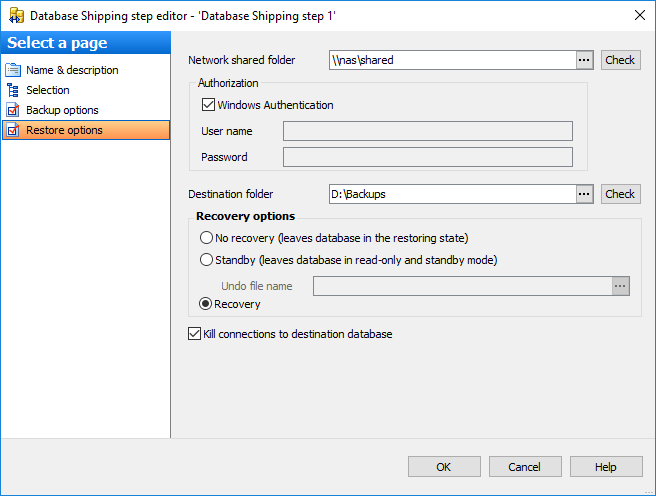Online Documentation for SQL Backup for SQL Server
Restore options
This page is used to define restore options for database shipping operation.

Network shared folder
Specify the backup shared folder for copying full backups of the source database. Both source and destination servers should have access to this folder otherwise database shipping cannot be performed. Specify the authorization parameters for the shared folder in the Authorization section. Click the Check button to make sure that the folder is accessible by both servers.
Authorization
This section is used to set authorization parameters to access network shared folder.
NB: When you set Windows Authentication please note that the credentials of the account which EMS SQL Backup Serviсе is running under will be used. Make sure that accounts from source and target servers can be authorized.
Destination folder
Specify the destination server folder which the backups will be shipped to. This folder must be set relatively to the destination server.
Recovery options
This group of options allows you to specify the recovery options to be applied to the restore operation.
![]() No recovery (leaves the database in the restoring state)
No recovery (leaves the database in the restoring state)
This option specifies that the restore operation does not roll back any uncommitted transactions.
NB: When this option is selected, the database is not usable in this intermediate, non-recovered state.
When used with a file or filegroup restore operation, this option forces the database to remain in the restoring state after the restore operation. This is useful in either of the following situations:
- a restore script is being run and the log is always being applied;
- a sequence of file restores is used and the database is not intended to be usable between two of the restore operations.
![]() Standby (leaves database in read-only and standby mode)
Standby (leaves database in read-only and standby mode)
This option allows the database to be brought up for read-only access between transaction log restores and can be used with either warm standby server situations or special recovery situations in which it is useful to inspect the database between log restores.
Undo file name
Specify the undo file name, so that the recovery effects can be undone. The same undo file can be used for consecutive restores of the same database.
NB: If free disk space is exhausted on the drive containing the specified undo file name, the restore operation stops.
![]() Recovery (rollbacks all uncommitted transactions)
Recovery (rollbacks all uncommitted transactions)
This option specifies that the restore operation rolls back any uncommitted transactions. After the recovery process the database is ready for use.
Set ![]() Kill connections to destination database option ON to forced disconnection of all processes.
Kill connections to destination database option ON to forced disconnection of all processes.


































































